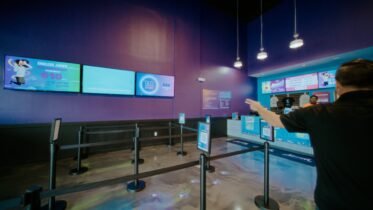Anyone who has driven for very long knows the frustrations of being stuck behind a truck on a two-lane road. You can’t see around it, and crossing the centerline to peek around seems like you’re taking your life into your own hands. Hampered by a lack of visibility around the back end of larger trucks, drivers often make risky maneuvers that could result in serious head-on collisions with approaching traffic. Driving at night or in bad weather can increase the risk of a crash.
Samsung has come up with a unique approach to addressing this tremendous road safety dilemma. In a recent project in Argentina, Samsung adapted its commercial video wall technology to create a safety truck prototype. The innovative “transparent” truck allows trailing drivers to get a clear view of the road ahead so they can pass safely.
Giving a Boost to Highway Safety
Highway fatalities continue to be a problem around the world. Despite recent gains in highway safety, the Insurance Institute of Highway Safety (IIHS) reported that there were 30,057 fatal motor vehicle crashes in the U.S. in 2013, with 32,719 total deaths. In further research, the IIHS calculated that one in 10 highway deaths occurs in a crash involving a large truck.
In the U.S., where 53-foot long trucks are common on the roadways, it can take 30 seconds or more to accelerate fast enough to pass a truck, according to the American Automobile Association. That leaves drivers and their passengers exposed to danger the entire time.
Samsung’s Video Wall Technology Creates Transparent Safety Truck
As a pilot aimed at raising awareness for road safety, Samsung developed the safety truck for a road test in Argentina. The team mounted a video camera on the front of the vehicle and streamed the images live to four Samsung video wall displays, connected to form a single large video wall on the rear of the trailer. Drivers had a clear view of what was ahead on the road, and they could make an informed decision about whether or not it was safe to pass. Oncoming headlights were visible at night or in the rain.
Samsung led the safety truck’s prototype development by providing large-format display samples, and then conducted a test with a local client. While the prototype truck is no longer on the road and there are no immediate plans for commercializing the solution, it has hinted at what is possible to make passing big trucks safer. Before more trucks can be outfitted with video walls, the technology must be fully tested and assessed, overcoming regulatory hurdles in various countries and obtaining the necessary permits and approvals.
Video Walls Enable Creativity and Engagement
The idea of transparent vehicles is quickly moving from science fiction to reality. Toyota used mirrors to make a “see-through” Toyota Prius, and Jaguar is working to eliminate blind spots with a 360-degree camera view around the car. Similar technology is being developed for windowless airplanes. Instead of viewing the sky through a small, narrow window, video walls will display images from the outside on the airplane cabin walls. It will look like passengers are floating through the clouds.
As creative uses advance with technology development, video walls are becoming an even more powerful tool in stationary places, giving businesses a new way to break through clutter and engage with a video-friendly audience in myriad environments. Samsung video walls and digital signage are seen in leading retailers, airports, businesses, public venues and educational facilities around the world. As pioneers of display technology, Samsung has developed ultra-narrow bezel, LED-lit video walls and complete solutions that include robust content management software and media players. Video walls can incorporate prerecorded programming or live video camera feeds for real-time data sharing and engagement, just like the safety truck. For complex deployments such as operations centers and control rooms, Samsung displays enable live video camera and computer feeds directly on the displays for real-time data sharing.
On the back of a truck, in a busy airport or amid a hot new clothing store, video wall technology delivers engaging, impactful content and organizational messaging that’s always on target.
![A New Vision for Road Safety: Meet the Samsung Safety Truck [VIDEO]](https://s47295.pcdn.co/wp-content/uploads/2016/06/safety-truck-three-1.jpg)







